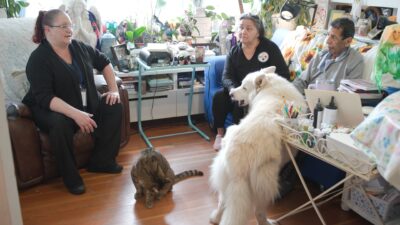According to the U.S. Census Bureau, of the 60.6 million people who spoke a language other than English at home in 2011, almost two-thirds (37.6 million) spoke Spanish. But depending on the country of origin, the word “hospice” or “hospicio” may have different meanings for Spanish speakers, and that meaning may be very different than its English-use definition. The resources on this page may help to bridge any misconceptions about hospice care and grief caused by language differences. Many hospices in the U.S. have physicians, nurses, social workers, nursing assistants and clergy who speak English and Spanish, and many hospices also rely on Spanish-speaking volunteers when caring for patients who speak Spanish only. If you are interested in the languages spoken at hospices, it’s important to ask a hospice representative about the hospice’s ability to provide Spanish speakers on a routine basis.
Señales de una muerte cercana – Signs of Approaching Death
A general overview of some of the symptoms dying persons may experience at the end of life. Individual experiences are influenced by many factors, including the person’s illness(es) and medications, but there are some physical changes that are common.
Haga clic aquí para conocer las señales de una muerte cercana
Understanding Hospice
Understanding Hospice covers the basic facts about hospice, including who can benefit from it, where it is provided, common illnesses and conditions, pain control, payment for hospice, and benefits of enrolling in hospice sooner rather than later in the course of illness.
Como Ayudar a un Nino – Helping a Child
Provides information about discussing a death with a child. Gives guidelines for developmental understanding of death, suggests using precise words, such a “death” as opposed to “loss,” addresses how to explain death, and how to deal with questions for which there is no answer, e.g., “Nobody knows for sure, but this is what I think.” It also addresses how children may be fearful about death of surviving family members and how they may not appear bereaved. For example, children may want to play or participate in their usual activities. This does not mean that they did not love the person who died; children generally do not tolerate long periods of sadness and find comfort in usual routines. It includes information about changes in behavior patterns or attitudes being a warning sign that the child may need bereavement services.
Como Cuidar a Alguien que Esta Muriendo – Caring for Someone Who is Dying
Jill left her job to care for her mother who is in the final stages of Alzheimer’s disease. Rosa cares for her husband, who is now dying from lung cancer. Bea’s father lives in another state, yet she still works closely with the local hospice, and is very involved in his care. Mark takes care of his partner, Tom, now in the final phase of AIDS.
In all of these cases, each individual struggles with caring for someone who is dying. Although the diseases, relationships, and circumstances are different, each person faces similar issues and difficulties. If you are caring for someone who is dying this information will not make your struggle easier, but it can offer some guidelines, provide a sense of understanding, and make your efforts less lonely.
Addresses:
- Understanding the dying process
- Planning for the future
- Advance directives
- Medical power of attorney
- Understanding how illness affects you
- Practical self-care
- Communicating your needs
Como Enfrentar una Perdia Repentina– Facing Sudden Loss
Sus Amigos Necesitan Ayuda– Your Friend Needs Help
Addresses interacting with people who may be seriously ill. The information includes suggestions of what to do and how to act, taken from experiences of hospice patients. They include: Be honest with me; Laugh with me, cry with me; Don’t feel sorry for me; Touch me; Let me talk about my illness if I want, Offer to help me do chores, Continue to be my friend.”
Cómo sobrellevar el duelo – How to cope with grief
A helpful booklet that explains how grief may be experienced and provides tips for coping with grief.


